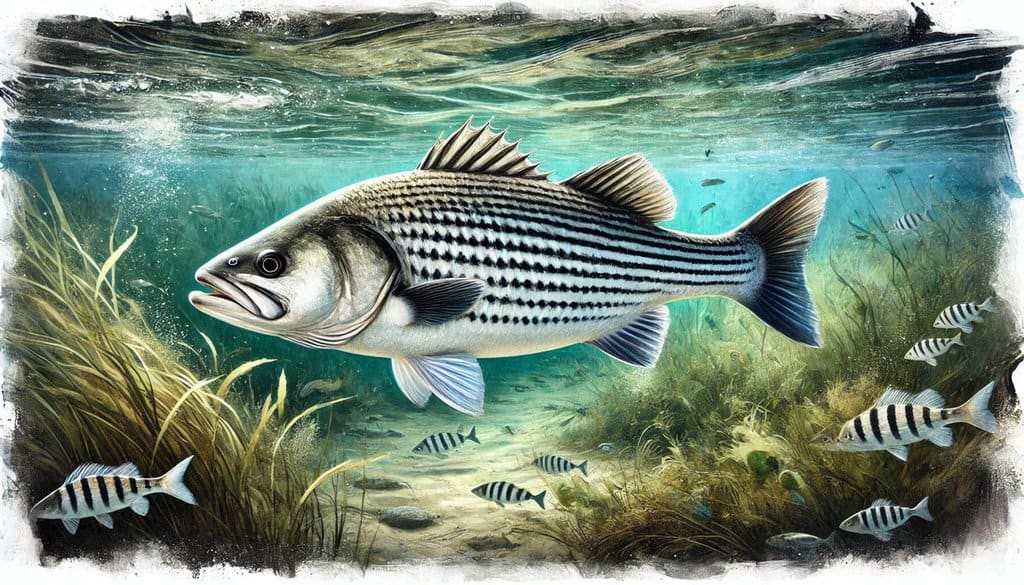The Striped Bass (Morone saxatilis) is a popular species for aquaponics systems due to its adaptability and commercial value. This anadromous(migrating up rivers from the sea to spawn) fish, native to the North American Atlantic Coast, is highly regarded for its recreational and commercial importance[4]. Striped Bass is known for its strong growth rates, resilience, and excellent taste, making it an attractive option for aquaponics enthusiasts[4].
Natural Habitat and Behavior
Striped Bass is naturally found in coastal waters, estuaries, and rivers along the Atlantic coast of North America[2][5].
In their natural habitat, Striped Bass exhibit migratory behavior influenced by estuary outflow and sea surface temperature[2]. They are known to forage in various habitats, including marshes, shoals, and channels[5].
Temperament: Striped Bass can be territorial and potentially aggressive, especially as they grow larger.
Compatibility: Due to their predatory nature, Striped Bass are best kept in species-specific tanks in aquaponics systems.
Water Requirements
Temperature Range
- Ideal temperature: 18-24°C (64.4-75.2°F)
- Striped Bass are sensitive to temperature changes, which can affect their migration timing and behavior[2].
pH Level
- Recommended pH range: 6.5-8.5
Water hardness
Striped Bass prefer moderate to hard water.
Oxygen Levels
- Ideal dissolved oxygen levels: >5 mg/L
- Striped Bass require well-oxygenated water for optimal health and growth.
Ammonia/Nitrate Sensitivity
Striped Bass are sensitive to ammonia and nitrite spikes. Regular water quality monitoring is essential.
Tank or Pond Setup
Tank/Pond Size Requirements
- Minimum recommended tank size: 1,000 liters (264 gallons) per adult fish
- Striped Bass require ample space due to their size and active nature.
Filtration & Aeration: Strong filtration and aeration are necessary to maintain water quality and oxygen levels.
Lighting Considerations: Natural lighting or a day/night cycle is beneficial for Striped Bass.
Tank Decorations/Substrate: Provide open swimming areas with some hiding spots or structures for shelter.
Feeding Requirements
Diet: Striped Bass are carnivorous. In the wild, their diet consists of macroinvertebrates and various fish species[5].
Feeding Techniques:
- Frequency: 2-3 times daily for juveniles, 1-2 times daily for adults
- Offer a variety of high-quality commercial fish feeds and occasional live or frozen foods.
Supplements or special diets: Supplement with vitamin-enriched foods to ensure proper nutrition.
Growth and Reproduction
Growth Rate: Striped Bass can grow rapidly under optimal conditions, reaching market size of 1.36-2.72 kg (3-6 lbs) in 18-24 months[4].
Physical Growth Indicators: As Striped Bass mature, they develop distinctive horizontal stripes along their sides.
Breeding Behavior: Breeding Striped Bass in aquaponics systems can be challenging and may require specialized techniques[4].
Care of Fry: Fry requires specialized care and feeding, typically starting with live foods such as rotifers and artemia.
Harvesting & Culinary Considerations
Growth to Harvest: Striped Bass are typically harvested at 1.36-2.72 kg (3-6 lbs), which takes about 18-24 months to achieve[4].
Culinary Uses: Striped Bass has a mild, sweet flavor and is highly valued in culinary applications. It can be prepared in various ways, including grilling, baking, and pan-searing.
Ethical Harvesting: Use humane harvesting methods such as rapid chilling or electrical stunning to minimize stress.
Pros and Cons
- Fast growth rate
- High market value
- Adaptable to various water conditions
- Requires large tank sizes
- Potential for aggressive behavior
- Challenging to breed in captivity
Overall Suitability: Striped Bass is best suited for experienced aquaponics practitioners with large-scale systems and a focus on commercial production.
Common Health Issues and Solutions
Potential Diseases: Striped Bass can be susceptible to bacterial and parasitic infections common in aquaculture settings.
Signs of Health Issues: Watch for changes in feeding behavior, abnormal swimming patterns, or visible lesions on the skin.
Treatment Recommendations: Consult with a fish health specialist for proper diagnosis and treatment. Maintain optimal water quality to prevent disease outbreaks.
Maintenance Tips for Long-Term Health
Maintenance Frequency: Perform regular water quality tests and system checks to ensure optimal conditions.
System checks: Monitor temperature, dissolved oxygen, pH, and nitrogen compounds (ammonia, nitrite, nitrate) regularly.
Handling Practices: Minimize handling to reduce stress. When necessary, use appropriate nets and ensure hands are wet before touching the fish.
Winter/Summer Care: Adjust feeding rates and system parameters according to seasonal temperature changes.
Tank Compatibility and Stocking: Stock at appropriate densities to prevent overcrowding and maintain water quality.
Closing Thoughts
Striped Bass offers a promising option for large-scale aquaponics systems due to its rapid growth and high market value. However, it requires careful management and substantial resources to thrive. Aquaponics enthusiasts considering Striped Bass should be prepared for the challenges of maintaining optimal conditions for this demanding species.
More fish species for aquaponics
External sources:
[1] https://www.semanticscholar.org/paper/11f0247aed0515b87f4241b9383a4c0dd72f2188
[2] https://www.ncbi.nlm.nih.gov/pmc/articles/PMC7810903/
[3] https://www.semanticscholar.org/paper/092aa91ec2dc2835efe7b49b583b218d5ecc35c8
[4] https://www.semanticscholar.org/paper/f76a6e87857e5d93bbb8821a33c8654453e7b34b
[5] https://www.semanticscholar.org/paper/ae04ca0699f46198a50b20f8954d6c4b7002c927

